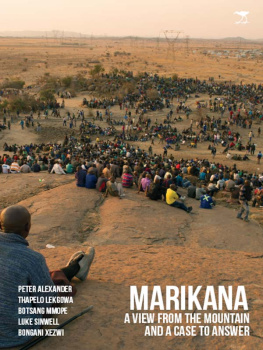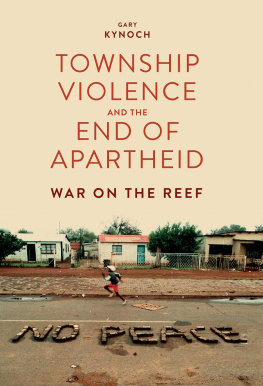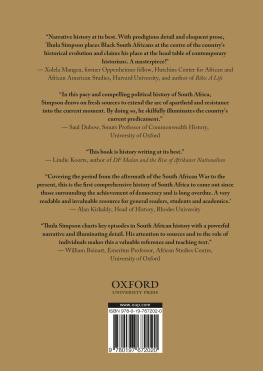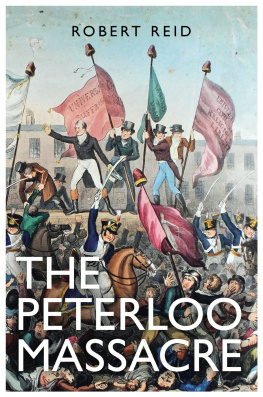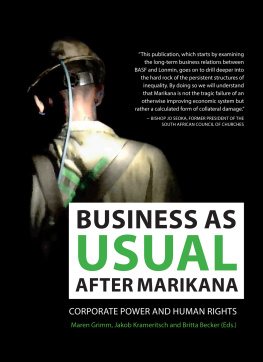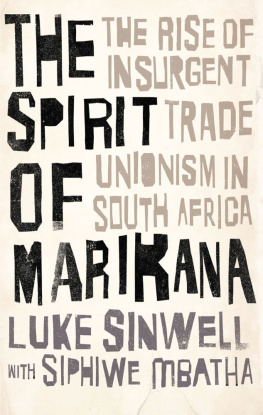MARIKANA
A VIEW FROM THE MOUNTAIN AND A CASE TO ANSWER
PETER ALEXANDER
THAPELO LEKGOWA
BOTSANG MMOPE
LUKE SINWELL
BONGANI XEZWI

A Note on Royalties
Royalties from this book will go to families of Marikana victims through a trust fund held by the South African Council of Churches. Any reader wishing to make a further donation should send it to Marikana Support Campaign Humanitarian Fund, SACC Deposit Account, Nedbank, Fox Street. Branch Code: 197908. Account No: for donations above R10 000 1979 263 108; for donations below R10 000 1979 263 116.
First published by Jacana Media (Pty) Ltd in 2012
10 Orange Street
Sunnyside
Auckland Park 2092
South Africa
+2711 628 3200
www.jacana.co.za
Peter Alexander, Thapelo Lekgowa,
Botsang Mmope, Luke Sinwell and Bongani Xezwi, 2012
Front cover photograph: Greg Marinovich
Maps: by John McCann
All rights reserved.
ISBN 978-1-4314-0733-0
Also available as an e-book
d-PDF ISBN 978-1-4314-0734-7
ePUB ISBN 978-1-4314-0735-4
mobi ISBN 978-1-4314-0736-1
Cover design Maggie Davey and Shawn Paikin
Job No. 001915
See a complete list of Jacana titles at www.jacana.co.za
CONTENTS
ACKNOWLEDGEMENTS
F UNDING FOR OUR RESEARCH has come from the Raith Foundation and from the South African Research Chair in Social Change, which is funded by the Department of Science and Technology, administered by the National Research Foundation and hosted by the Faculty of Humanities at the University of Johannesburg. We are grateful to Prof. Rory Ryan, Dean of Humanities, Prof. Lionel Posthumus, the facultys Vice Dean for Research, and Lucinda Landen, the Research Chairs Administration Officer for supporting the project.
Interviews were translated by Bridget Ndibongo, Mbongisi Dyantyi, Andisiwe Nakani and the research fieldworkers. Mamatlwe Sebei helped us by conducting preliminary interviews. We also received assistance from Marcelle Dawson, Shannon Walsh, David Moore and Fox Pooe.
John McCann provided the maps, which add considerably to this book. We are also very grateful to Joseph Mathunjwa and Asanda Benya and Greg Marinovich who kindly provided photographs.
The book was peer reviewed, with the reviewers providing supportive reports and valuable advice. James Nichol and Rehad Desai also read and commented on parts of the manuscript, as did members of Peter Alexanders family. Encouraging feedback was received at lectures given in Johannesburg, Detroit, Oxford and London.
Staff at Jacana, especially the editor Maggie Davey, did a superb job, working under considerable time pressures.
Most of all we are grateful to the Marikana strikers and community members we interviewed. They assisted us despite trauma, the watchful eyes of the police, and sometimes hunger. We were also assisted by Joseph Mathunjwa and other leaders of the Association of Mineworkers and Construction Union, and we are indebted to them as well. Many of those we interviewed participated in a reference group, which helped us correct mistakes. Remaining errors of fact, interpretation and judgment are our own. We have conveyed the perspective of workers involved in the massacre to the best of our ability, and we hope they will feel that we have done them justice.





PHOTOGRAPHS
: A VIEW FROM the mountain. Photograph taken from the top of the mountain on 15 August 2012. The area with trees is the hillock. Nkaneng informal settlement lies beyond, on the right near the top of the photograph. The pylons carry electricity to Lonmin, but none of his goes to the settlement. The area between the hillock and Nkaneng is the killing field, where the first deaths occurred on 16 August 2012.
Inside front cover: First blood. Photographs taken just after TV footage appeared to show workers charging at the police. Inside back cover, : Workers assemble on, and in front of, the mountain (to the left) and the hillock (to the right). The photograph was taken on 16 August 2012, just before the president of AMCU had left.
Inside back cover, Marikana workers celebrate their victory at Wonderkop Stadium on 18 September 2012.
The following photographs are acknowledged and credited:
Greg Marinovich:
Amandla magazine: inside front cover,
Reuters/The Bigger Picture: inside front cover,
Peter Alexander: pp.
Taphelo Lekgowa: pp.
Joseph Mathunjwa: inside back cover,
Asanda Benya:
1. INTRODUCTION
ENCOUNTERS IN MARIKANA
Luke Sinwell, Thapelo Lekgowa, Botsang Mmope and Bongani Xezwi
O N A BLISTERING HOT afternoon in Marikana just a few weeks after the brutal massacre of 16 August 2012, 10 000 striking workers carrying knobkerries and tall whips waited patiently in the sun. Four of us, researchers from the University of Johannesburg, found ourselves in the midst of the crowd. The mood was unclear, but seemed volatile. The workers were singing makuliwe [isiXhosa for let there be a fight]. We felt the force of the movement. One wrong move by the police could shift this peaceful moment into yet another bloody affair.
Following the massacre, workers had started moving in tight-knit battalions, using these formations to protect themselves, especially the strikes leaders. In what has become an emblemic feature of this workers resistance movement, the group stopped and kneeled about 20 metres from the police vehicles. At this point five madoda [men] stepped forward to negotiate. As the workers explained, we can all sing, but we cant all speak at once. The five madoda are the voices of the masses behind them, and they could be alternated at any time depending on negotiating capabilities and who they were speaking with. Their plan was to head for the smelter (where the platinum is processed and refined) demanding that it shut down its operations. At this stage, 95 per cent of workers at Lonmin, the third largest platinum mine in the world, were on strike. The smelter was the only unit still operating and the marchers wanted the workers there to join the strike.
Marikana was in effect witnessing an undeclared state of emergency. Police and Lonmin were on one side, and the workers were on the other. Over the next week, a thousand troops were deployed and orders were given by the police that people must stay off the streets. On this particular day, 12 September, the carloads of local and international media that had been camping out at the scene sped off quickly. It seemed like an evacuation. We wondered if we were in the wrong place at the wrong time. Two of us thought it was unsafe and wanted to flee; the other two felt we should stay and observe. In the end we didnt have much choice. Suddenly the mass of workers kneeled to the ground. There was no space to drive our car away, so we too kneeled down. We learned later from the workers that this was to ensure a calm and quiet environment for the five madodas negotiations. The workers were also very cautious. They crouched with their weapons down and to their side, as they did on 16 August when they were attacked. At the same time, they were ready to pick them up and fight, but only if it was necessary to defend themselves.

